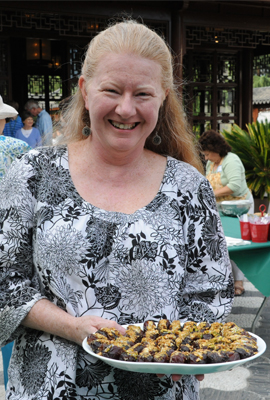The blog of The Huntington Library, Art Museum, and Botanical Gardens.
MR. HUNTINGTON'S GARDEN | Save the Date Palm
Posted on Mon., April 18, 2011
Botanist that I am, seemingly trivial and arcane plant knowledge sometimes gets in the way of simple, normal experiences. Yesterday was Palm Sunday, which always means to me that people make convenient and curious choices while trying to round up palm fronds for decoration. At our church, the altar greenery was sago palm, probably because the unfailingly rich green orderliness and ready availability of this cycad make it a good choice for floral arrangements.
But the sago palm (Cycas revoluta) is not a palm, not even a flowering plant. It is one of the great botanical mysteries that cycads and palms are so similar in aspect, when indeed they are very distant evolutionarily. We think of cycads as remnants of ancient plant lineages, survivors from the age of coal, the times of the dinosaurs. Palms, so similar to cycads at first glance, are very different critters in structure, anatomy, and reproductive biology, and they are much more recent arrivals in the tree of life. Most tellingly, cycads make their seed in cones, whereas palms make flowers that yield seed-bearing fruit. To a botanist, this is a big deal. Grouping cycads and palms would be like lumping earthworms with snakes just because they are long and narrow and like to hang around in similar places.
Unfortunately, even when real palm leaves are used for Palm Sunday, it may not be quite right (for a botanist) due to the serious temptation to use any palm available. The Biblical palm of importance is not just any old palm, it is certainly the date palm, Phoenix dactylifera, which has regrettably little meaning for Americans in 2011. In our lives, dates are oddities and gain no respect considering their historical importance to Mediterranean and African culture. We forget that refined sugars have only become widely available in recent centuries, and not many of us thatch our roofs with palm fronds. For people in Old World dryland regions, dates were important fruit, sweet, energy-packed vessels that could be dried and stored, and used in hundreds of ways. And date palms are among the great plants of antiquity, rife with uses and symbolism.

Kitty Connolly, the associate director of education at The Huntington, with a platter of stuffed dates.
To the surprise of some, there is a multi-trunk date palm specimen at The Huntington, right in the middle of the Palm Garden near the new path. And several of its relatives, other members of the genus Phoenix, are common here and elsewhere. Just inside the Gardens entryway are two large clumps of the Senegal date palm, Phoenix reclinata, a recumbent octopus of a plant that takes more space than many home gardeners are able to allow. Most common in the Southern California landscape is the Canary Island Date Palm, Phoenix canariensis, the thick-trunked, large-crowned pinnate-leaved palm of our roadsides. But in the last couple of decades there has been a quiet revolution as the pygmy date palm, Phoenix roebelinii, has moved from interior mallscapes to becoming a common element in regional landscapes, probably outnumbering its beefier cousin. It is worth noting that we will be adding more real date palms to the landscape in the future. As we reconsider the entry experience for visitors, the palms along the road through the orange groves recall the ranch, and the idea emerges to bring additional palms, probably date palms, into the landscape we are developing for the visitors' center. Of course, if we want dates, we'll have to include both male and female plants, as these trees are unisexual. Perhaps this will give us the chance to say a little more about their lifestyles and their importance.
While thinking of these many palms and their meaning, I was also among the 200 people prepping for the Gardens Volunteer group potluck dinner on Sunday evening, in the Chinese Garden. And there I was, on Palm Sunday, serving up lettuce cups, when Associate Director of Education Kitty Connolly arrived with her contribution, stuffed dates. That was a good choice for the day.
Jim Folsom is the Telleen/Jorgensen Director of the Botanical Gardens at The Huntington.
